Intro
Yoga is an ancient practice that combines physical postures, breathing techniques, and meditation to promote overall well-being. For beginners, starting a yoga practice can seem intimidating, but with the right guidance, it can be a rewarding and transformative experience. In this article, we will explore the benefits of yoga for beginners, discuss the essential yoga positions for beginners, and provide tips for getting started with a yoga practice.
Yoga is a low-impact exercise that can help improve flexibility, balance, strength, and cardiovascular health. It can also reduce stress, improve sleep quality, and boost mood. With regular practice, yoga can help beginners develop greater body awareness, improve their posture, and enhance their overall physical and mental well-being. Whether you're looking to improve your physical health, reduce stress, or simply feel more centered and grounded, yoga is an excellent choice.
For those new to yoga, it's essential to start with basic yoga positions that are easy to learn and modify. These foundational poses will help build strength, flexibility, and confidence, making it easier to progress to more advanced poses. In the following sections, we will explore the essential yoga positions for beginners, including standing poses, seated poses, backbends, and forward bends. We will also discuss the benefits of each pose, provide modifications and variations, and offer tips for getting the most out of your practice.
Getting Started with Yoga
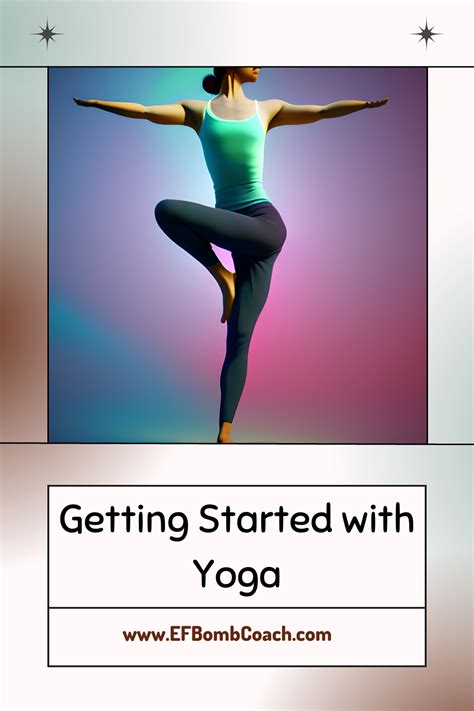
Before diving into the world of yoga, it's essential to understand the basics. This includes investing in a good yoga mat, finding a quiet and comfortable practice space, and dressing in loose, comfortable clothing. It's also crucial to listen to your body and honor its limitations, especially when starting out. This means modifying or avoiding poses that cause discomfort or pain, and taking regular breaks to rest and recharge.
Setting Up Your Practice Space
To get the most out of your yoga practice, it's essential to create a peaceful and inviting practice space. This can be as simple as finding a quiet corner in your home, rolling out your yoga mat, and lighting some candles. You can also invest in a few props, such as blocks, straps, and blankets, to help modify poses and enhance your practice.Essential Yoga Positions for Beginners
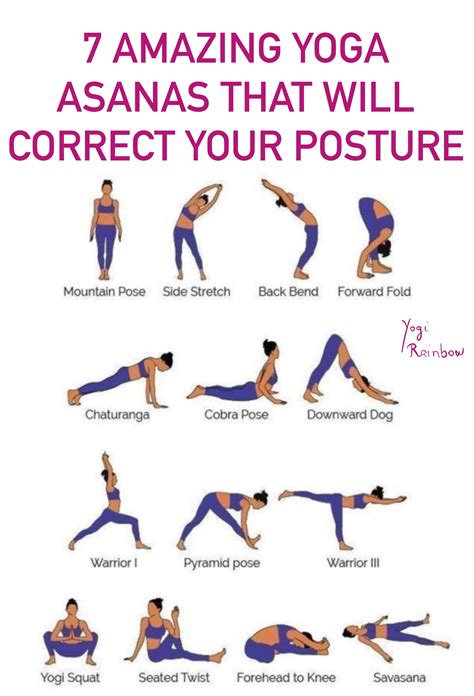
The following yoga positions are perfect for beginners, as they are easy to learn, modify, and practice. These poses will help build strength, flexibility, and confidence, making it easier to progress to more advanced poses.
- Mountain Pose (Tadasana): This foundational standing pose helps establish good posture, balance, and alignment.
- Downward-Facing Dog (Adho Mukha Svanasana): This pose stretches the hamstrings, calves, and spine, while strengthening the arms and shoulders.
- Cobra Pose (Bhujangasana): This backbend strengthens the back muscles, opens the chest, and improves flexibility in the shoulders and upper back.
- Cat-Cow Pose (Marjaryasana-Bitilasana): This pose gently warms up the spine, stretches the neck and torso, and prepares the body for more advanced poses.
- Child's Pose (Balasana): This resting pose stretches the back, hips, and legs, while calming the mind and promoting relaxation.
Modifying and Variating Poses
One of the beauty of yoga is that it can be modified and varied to suit different needs and abilities. This means using props, such as blocks and straps, to support the body, or modifying poses to reduce intensity or discomfort. It's also essential to listen to your body and honor its limitations, especially when starting out.Standing Yoga Positions
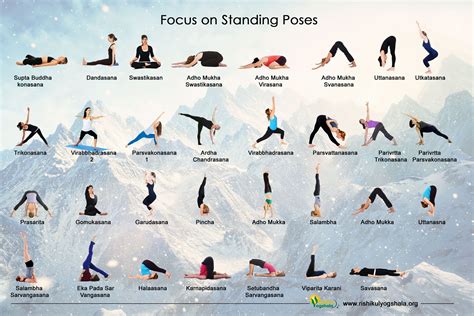
Standing yoga positions are excellent for building strength, improving balance, and enhancing overall physical and mental well-being. These poses include:
- Tree Pose (Vrksasana): This balancing pose strengthens the ankles, calves, and spine, while improving focus and concentration.
- Warrior Pose (Virabhadrasana): This standing pose strengthens the legs, hips, and core, while stretching the chest and shoulders.
- Triangle Pose (Trikonasana): This standing pose stretches the hips, thighs, and spine, while strengthening the arms and shoulders.
Benefits of Standing Yoga Positions
Standing yoga positions offer numerous benefits, including improved balance, strength, and flexibility. These poses can also help reduce stress, improve mood, and enhance overall physical and mental well-being.Seated Yoga Positions
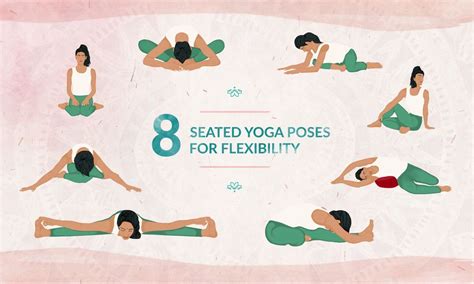
Seated yoga positions are perfect for stretching the hips, thighs, and spine, while strengthening the arms and shoulders. These poses include:
- Seated Forward Fold (Paschimottanasana): This pose stretches the hamstrings, calves, and spine, while strengthening the arms and shoulders.
- Seated Twist (Bharadvajasana): This pose stretches the torso, hips, and spine, while strengthening the arms and shoulders.
- Easy Pose (Sukhasana): This pose stretches the hips, thighs, and spine, while calming the mind and promoting relaxation.
Modifying Seated Yoga Positions
Seated yoga positions can be modified to reduce intensity or discomfort. This includes using props, such as blocks and straps, to support the body, or modifying poses to reduce depth or intensity.Backbends and Forward Bends
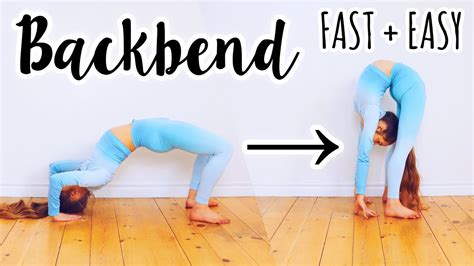
Backbends and forward bends are essential yoga positions that can help improve flexibility, strength, and overall physical and mental well-being. These poses include:
- Bridge Pose (Setu Bandha Sarvangasana): This backbend strengthens the back muscles, opens the chest, and improves flexibility in the shoulders and upper back.
- Sphinx Pose (Salamba Bhujangasana): This backbend strengthens the back muscles, opens the chest, and improves flexibility in the shoulders and upper back.
- Plow Pose (Halasana): This forward bend stretches the shoulders, upper back, and spine, while calming the mind and promoting relaxation.
Benefits of Backbends and Forward Bends
Backbends and forward bends offer numerous benefits, including improved flexibility, strength, and overall physical and mental well-being. These poses can also help reduce stress, improve mood, and enhance overall physical and mental well-being.Yoga for Stress Relief and Relaxation
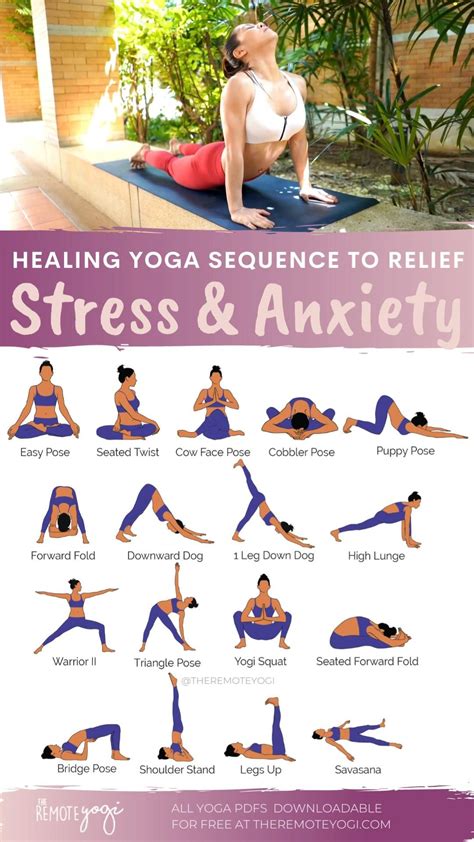
Yoga is an excellent way to reduce stress, improve mood, and enhance overall physical and mental well-being. This includes practicing relaxation techniques, such as deep breathing, progressive muscle relaxation, and meditation.
- Child's Pose (Balasana): This resting pose stretches the back, hips, and legs, while calming the mind and promoting relaxation.
- Legs Up The Wall Pose (Viparita Karani): This pose calms the mind, reduces stress, and promotes relaxation.
- Savasana (Corpse Pose): This pose calms the mind, reduces stress, and promotes relaxation.
Benefits of Yoga for Stress Relief and Relaxation
Yoga offers numerous benefits for stress relief and relaxation, including reduced stress, improved mood, and enhanced overall physical and mental well-being. This includes practicing relaxation techniques, such as deep breathing, progressive muscle relaxation, and meditation.What are the benefits of yoga for beginners?
+Yoga offers numerous benefits for beginners, including improved flexibility, strength, balance, and overall physical and mental well-being. It can also reduce stress, improve mood, and enhance overall physical and mental well-being.
How often should I practice yoga as a beginner?
+As a beginner, it's recommended to practice yoga 2-3 times per week, with at least one day of rest in between. This allows the body to recover and adapt to the new demands of yoga.
What are some essential yoga props for beginners?
+Essential yoga props for beginners include a good yoga mat, blocks, straps, and blankets. These props can help modify poses, reduce intensity, and enhance overall practice.
How can I modify yoga poses to suit my needs and abilities?
+Yoga poses can be modified to suit different needs and abilities by using props, such as blocks and straps, to support the body, or modifying poses to reduce intensity or discomfort.
What are some common mistakes to avoid as a beginner yogi?
+Common mistakes to avoid as a beginner yogi include pushing past pain or discomfort, not listening to the body, and not modifying poses to suit individual needs and abilities.
In conclusion, yoga is an excellent way to improve overall physical and mental well-being, reduce stress, and enhance flexibility, strength, and balance. By starting with basic yoga positions, modifying and varying poses, and listening to the body, beginners can develop a strong foundation for a lifelong yoga practice. We invite you to share your yoga journey with us, ask questions, and explore the numerous benefits of yoga for beginners. Whether you're a seasoned yogi or just starting out, we encourage you to join the conversation and discover the transformative power of yoga for yourself.
